engine BMW 528I 2001 E39 Central Body Electronics ZKE Manual
[x] Cancel search | Manufacturer: BMW, Model Year: 2001, Model line: 528i, Model: BMW 528i 2001 E39Pages: 80, PDF Size: 4.14 MB
Page 7 of 80
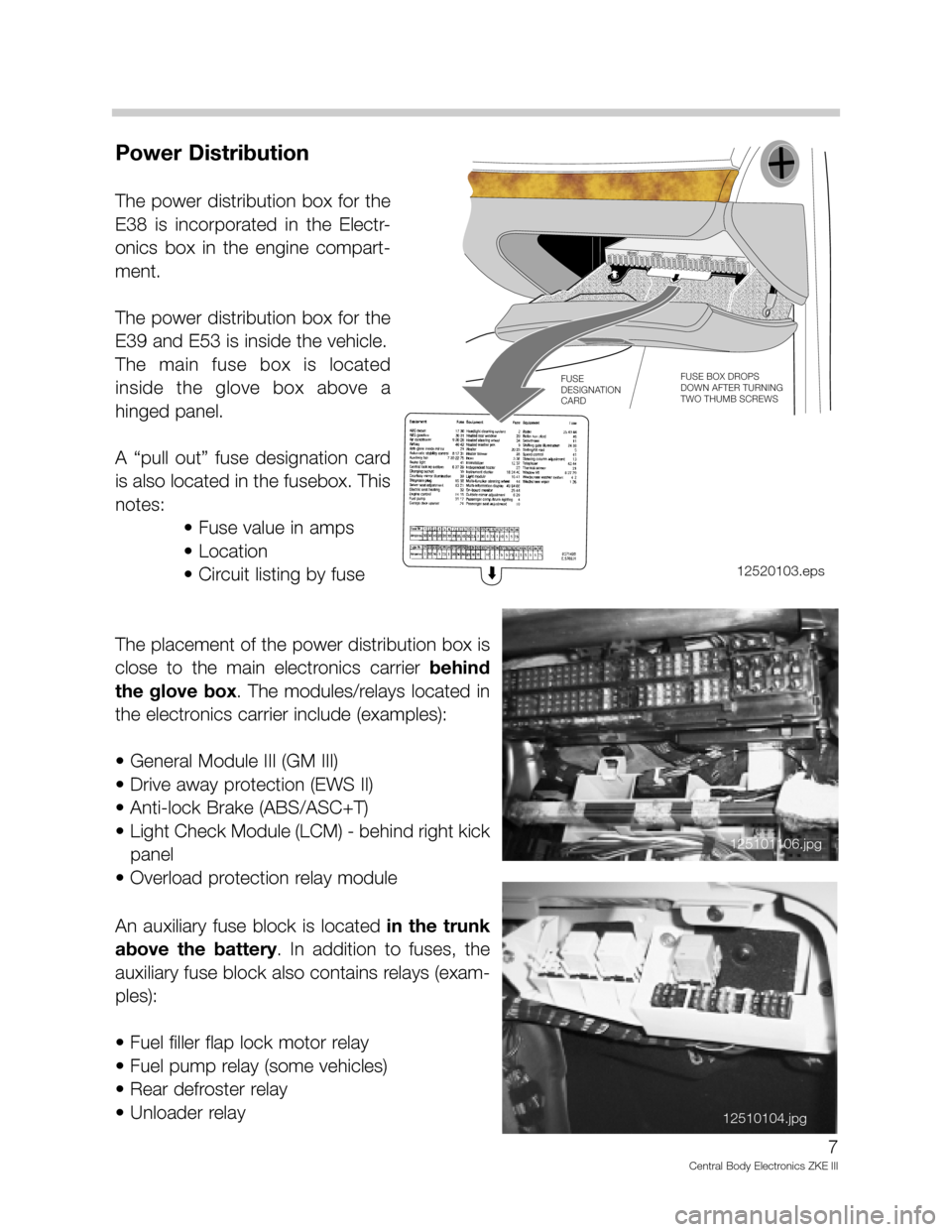
7
Central Body Electronics ZKE III
Power Distribution
The power distribution box for the
E38 is incorporated in the Electr-
onics box in the engine compart-
ment.
The power distribution box for the
E39 and E53 is inside the vehicle.
The main fuse box is located
inside the glove box above a
hinged panel.
A “pull out” fuse designation card
is also located in the fusebox. This
notes:
• Fuse value in amps
• Location
• Circuit listing by fuse
The placement of the power distribution box is
close to the main electronics carrier behind
the glove box. The modules/relays located in
the electronics carrier include (examples):
• General Module III (GM III)
• Drive away protection (EWS II)
• Anti-lock Brake (ABS/ASC+T)
• Light Check Module (LCM) - behind right kick
panel
• Overload protection relay module
An auxiliary fuse block is located in the trunk
above the battery. In addition to fuses, the
auxiliary fuse block also contains relays (exam-
ples):
• Fuel filler flap lock motor relay
• Fuel pump relay (some vehicles)
• Rear defroster relay
• Unloader relay
FUSE
DESIGNATION
CARDFUSE BOX DROPS
DOWN AFTER TURNING
TWO THUMB SCREWS
12520103.eps
12510104.jpg125101106.jpg
Page 16 of 80
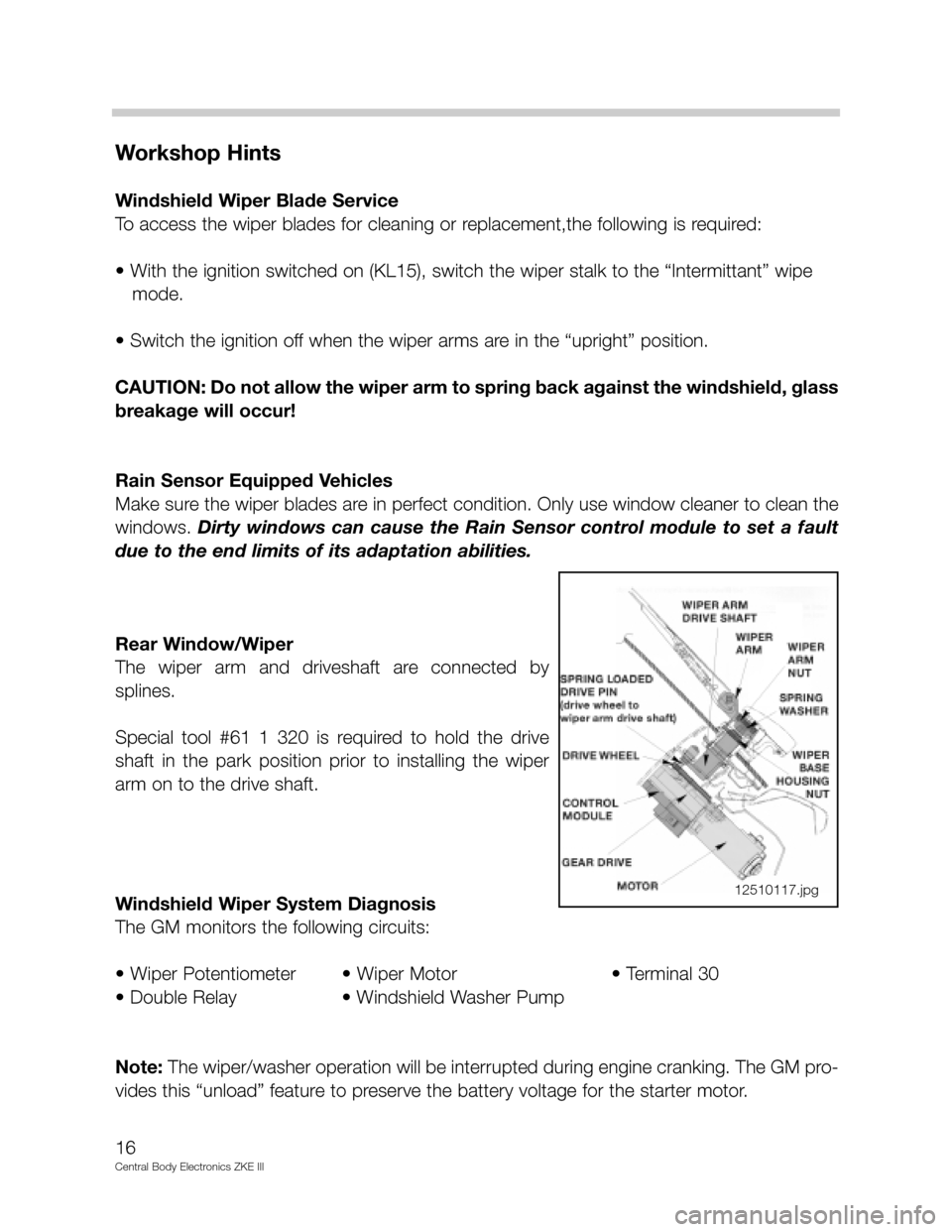
Workshop Hints
Windshield Wiper Blade Service
To access the wiper blades for cleaning or replacement,the following is required:
• With the ignition switched on (KL15), switch the wiper stalk to the “Intermittant” wipe
mode.
• Switch the ignition off when the wiper arms are in the “upright” position.
CAUTION: Do not allow the wiper arm to spring back against the windshield, glass
breakage will occur!
Rain Sensor Equipped Vehicles
Make sure the wiper blades are in perfect condition. Only use window cleaner to clean the
windows. Dirty windows can cause the Rain Sensor control module to set a fault
due to the end limits of its adaptation abilities.
Rear Window/Wiper
The wiper arm and driveshaft are connected by
splines.
Special tool #61 1 320 is required to hold the drive
shaft in the park position prior to installing the wiper
arm on to the drive shaft.
Windshield Wiper System Diagnosis
The GM monitors the following circuits:
• Wiper Potentiometer • Wiper Motor • Terminal 30
• Double Relay • Windshield Washer Pump
Note: The wiper/washer operation will be interrupted during engine cranking. The GM pro-
vides this “unload” feature to preserve the battery voltage for the starter motor.
16
Central Body Electronics ZKE III
12510117.jpg
Page 18 of 80
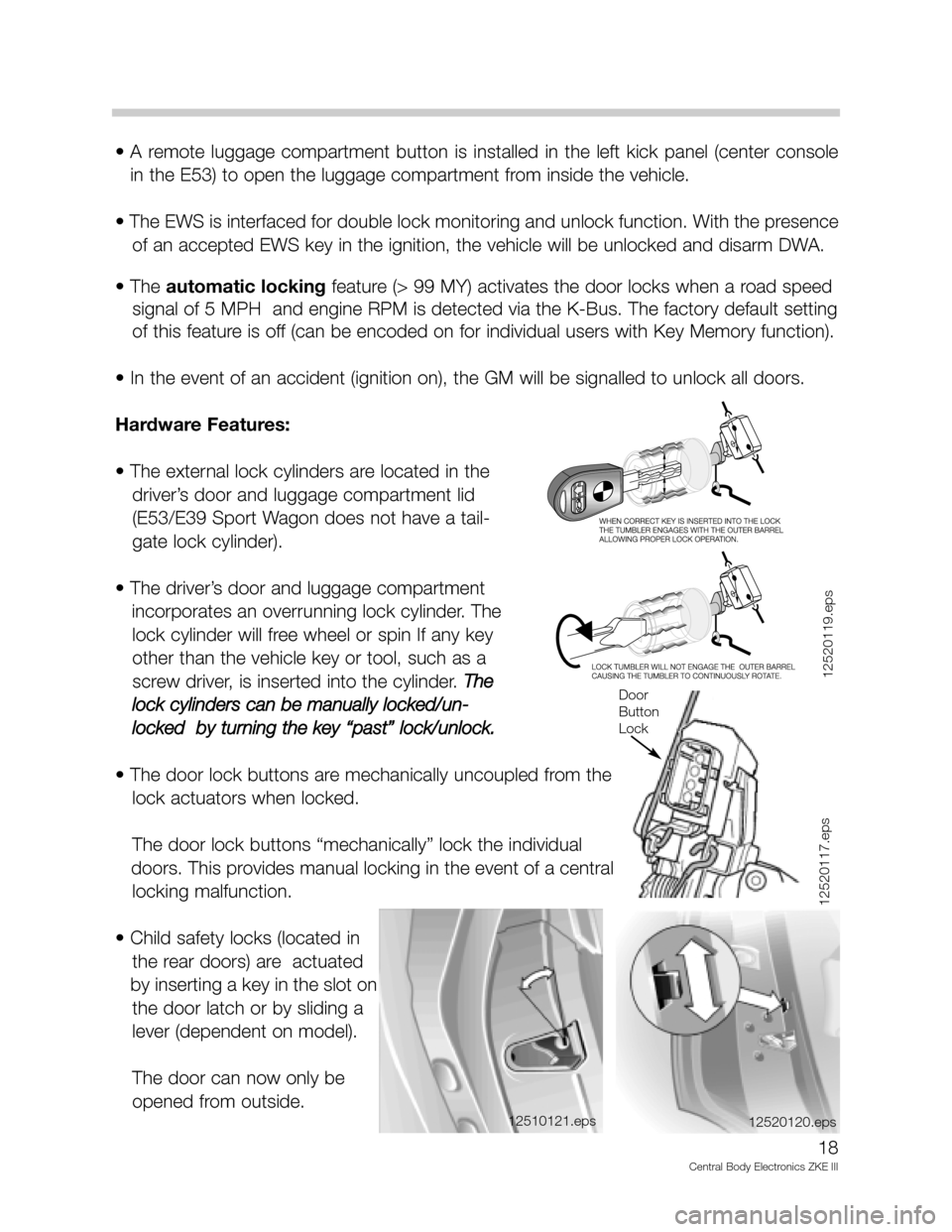
• A remote luggage compartment button is installed in the left kick panel (center console
in the E53) to open the luggage compartment from inside the vehicle.
• The EWS is interfaced for double lock monitoring and unlock function. With the presence
of an accepted EWS key in the ignition, the vehicle will be unlocked and disarm DWA.
• The automatic locking feature (> 99 MY) activates the door locks when a road speed
signal of 5 MPH and engine RPM is detected via the K-Bus. The factory default setting
of this feature is off (can be encoded on for individual users with Key Memory function).
• In the event of an accident (ignition on), the GM will be signalled to unlock all doors.
Hardware Features:
• The external lock cylinders are located in the
driver’s door and luggage compartment lid
(E53/E39 Sport Wagon does not have a tail-
gate lock cylinder).
• The driver’s door and luggage compartment
incorporates an overrunning lock cylinder. The
lock cylinder will free wheel or spin If any key
other than the vehicle key or tool, such as a
screw driver, is inserted into the cylinder. The
lock cylinders can be manually locked/un-
locked by turning the key “past” lock/unlock.
• The door lock buttons are mechanically uncoupled from the
lock actuators when locked.
The door lock buttons “mechanically” lock the individual
doors. This provides manual locking in the event of a central
locking malfunction.
• Child safety locks (located in
the rear doors) are actuated
by inserting a key in the slot on
the door latch or by sliding a
lever (dependent on model).
The door can now only be
opened from outside.
18
Central Body Electronics ZKE III
Door
Button
Lock
12520117.eps
12520119.eps
12510121.eps
12520120.eps
Page 37 of 80
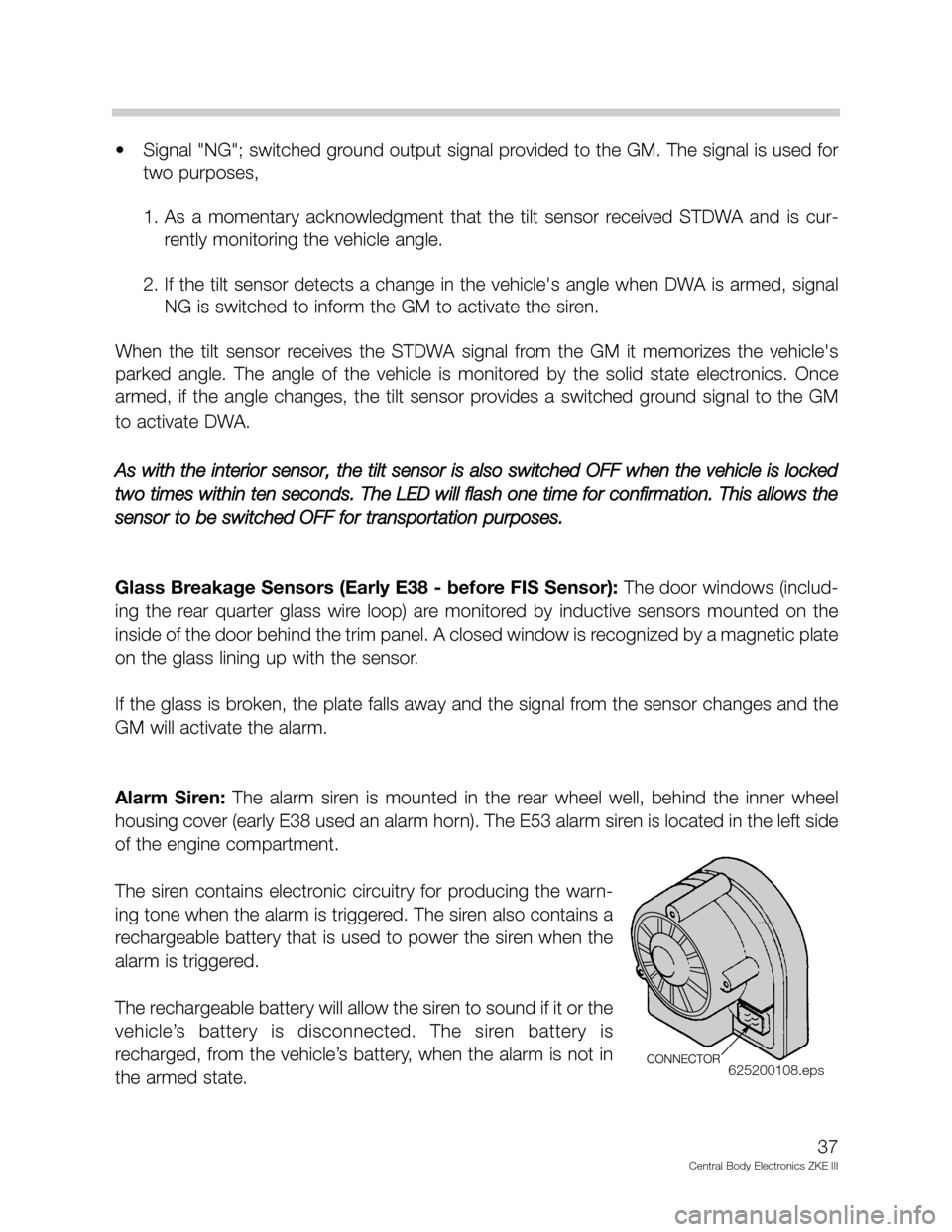
• Signal "NG"; switched ground output signal provided to the GM. The signal is used for
two purposes,
1. As a momentary acknowledgment that the tilt sensor received STDWA and is cur-
rently monitoring the vehicle angle.
2. If the tilt sensor detects a change in the vehicle's angle when DWA is armed, signal
NG is switched to inform the GM to activate the siren.
When the tilt sensor receives the STDWA signal from the GM it memorizes the vehicle's
parked angle. The angle of the vehicle is monitored by the solid state electronics. Once
armed, if the angle changes, the tilt sensor provides a switched ground signal to the GM
to activate DWA.
As with the interior sensor, the tilt sensor is also switched OFF when the vehicle is locked
two times within ten seconds. The LED will flash one time for confirmation. This allows the
sensor to be switched OFF for transportation purposes.
Glass Breakage Sensors (Early E38 - before FIS Sensor): The door windows (includ-
ing the rear quarter glass wire loop) are monitored by inductive sensors mounted on the
inside of the door behind the trim panel. A closed window is recognized by a magnetic plate
on the glass lining up with the sensor.
If the glass is broken, the plate falls away and the signal from the sensor changes and the
GM will activate the alarm.
Alarm Siren: The alarm siren is mounted in the rear wheel well, behind the inner wheel
housing cover (early E38 used an alarm horn). The E53 alarm siren is located in the left side
of the engine compartment.
The siren contains electronic circuitry for producing the warn-
ing tone when the alarm is triggered. The siren also contains a
rechargeable battery that is used to power the siren when the
alarm is triggered.
The rechargeable battery will allow the siren to sound if it or the
vehicle’s battery is disconnected. The siren battery is
recharged, from the vehicle’s battery, when the alarm is not in
the armed state.
37
Central Body Electronics ZKE III
625200108.eps
Page 69 of 80
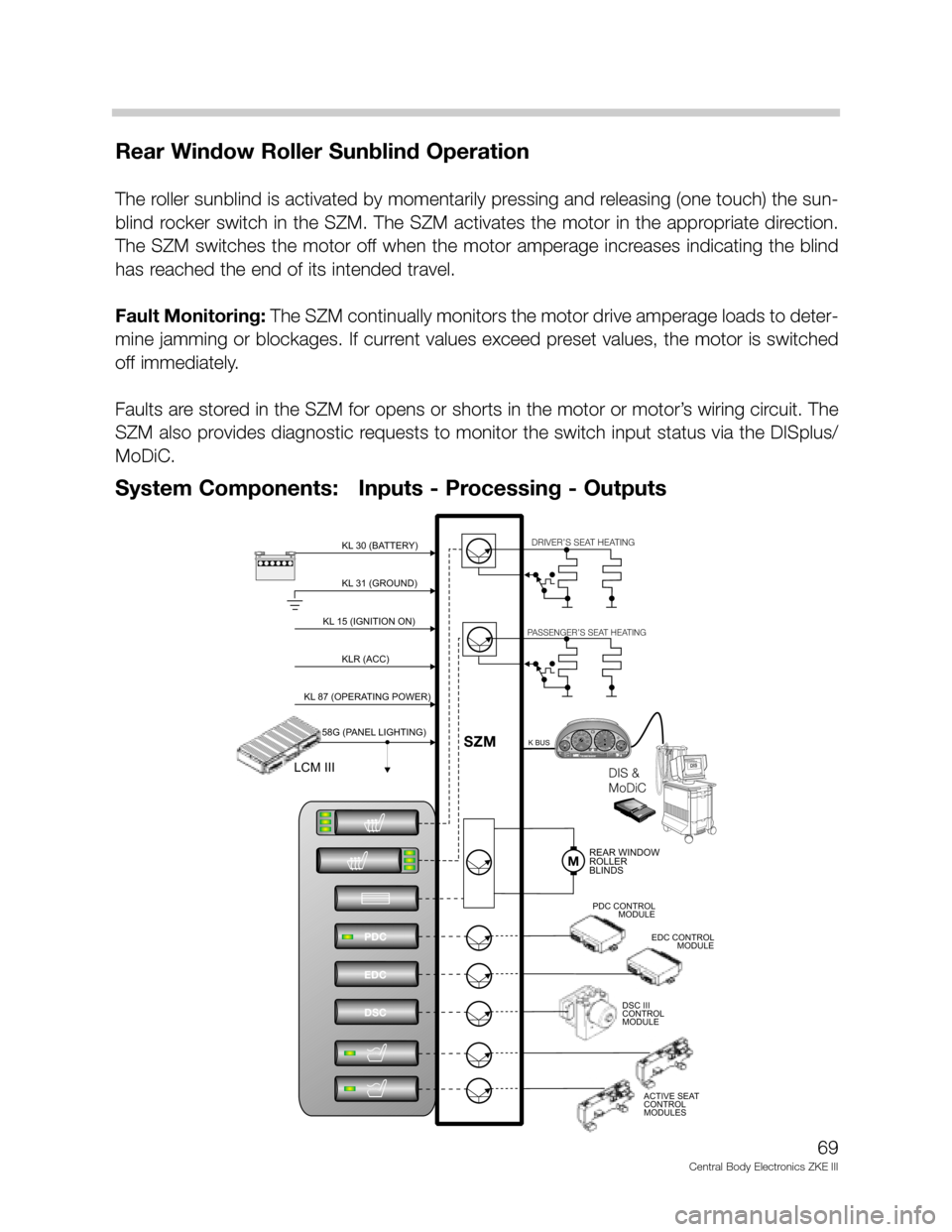
Rear Window Roller Sunblind Operation
The roller sunblind is activated by momentarily pressing and releasing (one touch) the sun-
blind rocker switch in the SZM. The SZM activates the motor in the appropriate direction.
The SZM switches the motor off when the motor amperage increases indicating the blind
has reached the end of its intended travel.
Fault Monitoring: The SZM continually monitors the motor drive amperage loads to deter-
mine jamming or blockages. If current values exceed preset values, the motor is switched
off immediately.
Faults are stored in the SZM for opens or shorts in the motor or motor’s wiring circuit. The
SZM also provides diagnostic requests to monitor the switch input status via the DISplus/
MoDiC.
69
Central Body Electronics ZKE III
KL 31 (GROUND)KL 31 (GROUND)
DIS
DIS
BMWDIS
B
M
WD
I
S
BMWDIS
BMW
DIS
D
ia
g
n
o
s
e
-
a
n
d
In
fo
r
m
a
ti
o
n
S
y
s
t
e
mDIS &
MoDiCDIS &
MoDiC
M
o
Di
C
0½
CHECK
ENGINE
CHECK
ENGINEOIL SERVICEOIL SERVICEINSPECTIONINSPECTIONP
1/min
x1000km/hELECTRONICMPH1
2020404060608080100180160140 1201002001202201402400234
5
6
7!!ABS20 DIGIT READOUT20 DIGIT READOUT
123456
prnd432
m
prnd432
m
122.4 +72.0 fo
+72.0 fomiles0
10
15 20 40
KL 30 (BATTERY)KL 30 (BATTERY)-+
KL 15 (IGNITION ON)KL 15 (IGNITION ON)
KLR (ACC)KLR (ACC)
KL 87 (OPERATING POWER)KL 87 (OPERATING POWER)
58G (PANEL LIGHTING)58G (PANEL LIGHTING)
LCM IIILCM III
PDC
EDC
DSC
MREAR WINDOW
ROLLER
BLINDSREAR WINDOW
ROLLER
BLINDS
DRIVER’S SEAT HEATINGDRIVER’S SEAT HEATING
PASSENGER’S SEAT HEATINGPASSENGER’S SEAT HEATING
K BUSK BUS
PDC CONTROL
MODULEPDC CONTROL
MODULE
EDC CONTROL
MODULEEDC CONTROL
MODULE
SZMSZM
DSC III
CONTROL
MODULEDSC III
CONTROL
MODULE
ACTIVE SEAT
CONTROL
MODULESACTIVE SEAT
CONTROL
MODULES
System Components: Inputs - Processing - Outputs
Page 74 of 80

Principle of Operation
Control logic (example E38) includes:
• Servotronic control electronics active with KL R being switched "ON" - ensure no delay
in operation if engine is started and vehicle is immediately driven.
• Plausibility check for speed signal - the control electronics monitor both the Speed sig-
nal "A" from the IKE and the vehicle speed signal on the K-Bus.
• The ability to detect both acceleration and deceleration from the two speed signals - the
speed signal from the IKE is updated every two seconds.
• The servotronic assist is reduced gradually when the vehicle is under acceleration.
• The servotronic assist is adopted to the lower direct reading during decel or braking.
Electric/electronic failures with the servotronic system will result in the following:
• Power/electronic failure of the control module or solenoid - steering assist the same as
high speed driving (increased effort).
• Vehicle speed signal missing - control module retains the assist mode in effect when the
speed signal was lost.
• Speed signal implausible - steering assist the same as high speed driving (increased
effort).
The GM also provides the diagnostic “gateway” to the Servotronic status and Component
Activation via the DISplus/MoDiC.
74
Central Body Electronics ZKE III